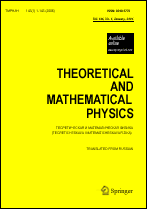|
This article is cited in 6 scientific papers (total in 6 papers)
The nature of the bufferness phenomenon in weakly dissipative systems
A. Yu. Kolesova, N. Kh. Rozovb
a P. G. Demidov Yaroslavl State University
b M. V. Lomonosov Moscow State University, Faculty of Mechanics and Mathematics
Abstract:
We propose a mechanism for accumulating attractors in finite-dimensional weakly dissipative systems. The essence of this mechanism is that if a Hamiltonian or a conservative system with one and a half or more degrees of freedom is perturbed by small additional terms ensuring that it is dissipative, then under certain conditions, the number of its attractors appearing in small neighborhoods of different elliptic equilibriums or cycles of the nonperturbed system can increase without bound as the perturbations tend to zero. We consider meaningful examples from mechanics and radio physics: models of the bouncing ball dynamics, Fermi accelerations, the linear oscillator with impacts, and the self-excited oscillator with a discrete sequence of $RLC$ circuits in the feedback circuit.
Keywords:
attractors, periodic motions, bufferness phenomenon, mappings, relay systems.
Received: 11.11.2005
Revised: 16.06.2005
Citation:
A. Yu. Kolesov, N. Kh. Rozov, “The nature of the bufferness phenomenon in weakly dissipative systems”, TMF, 146:3 (2006), 447–466; Theoret. and Math. Phys., 146:3 (2006), 376–392
Linking options:
https://www.mathnet.ru/eng/tmf2047https://doi.org/10.4213/tmf2047 https://www.mathnet.ru/eng/tmf/v146/i3/p447
|


|




 Contact us:
Contact us: Terms of Use
Terms of Use
 Registration to the website
Registration to the website Logotypes
Logotypes








 Citation in format
Citation in format 
